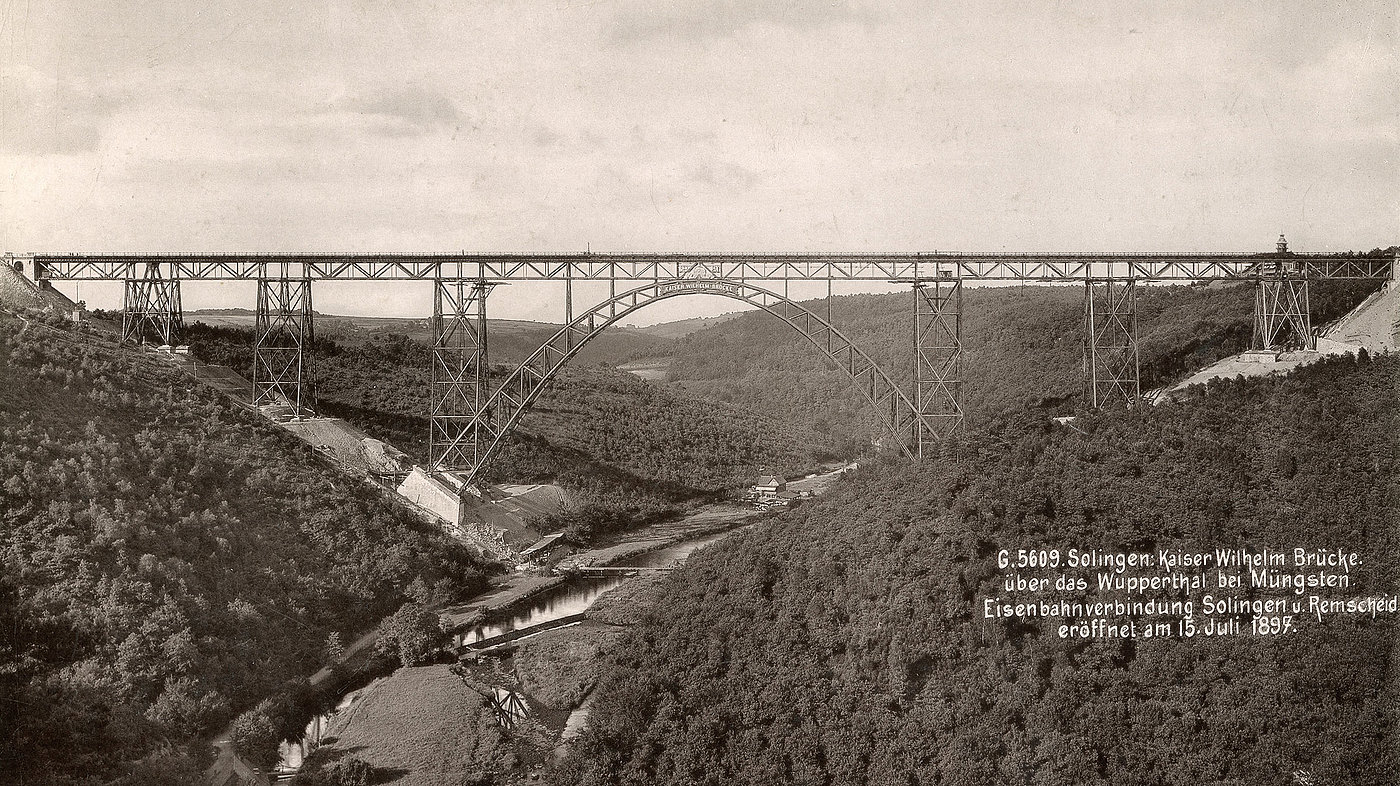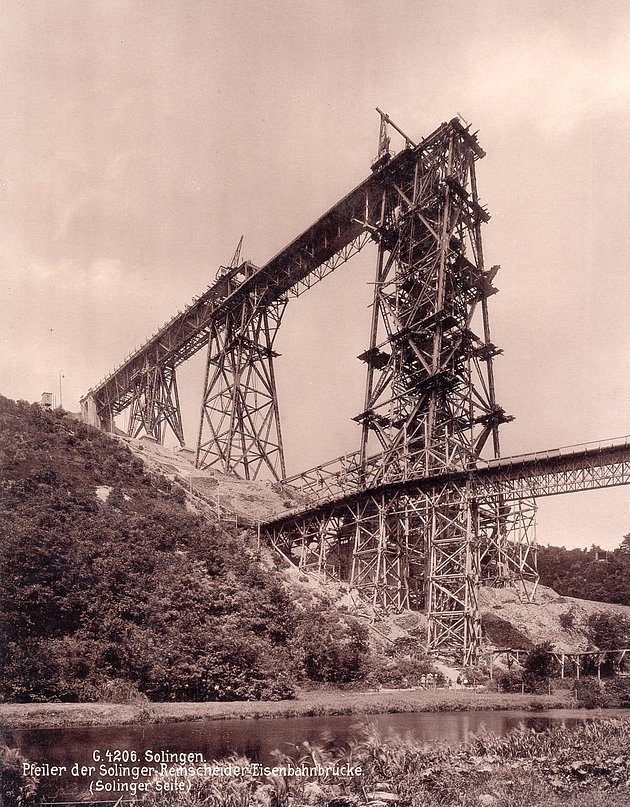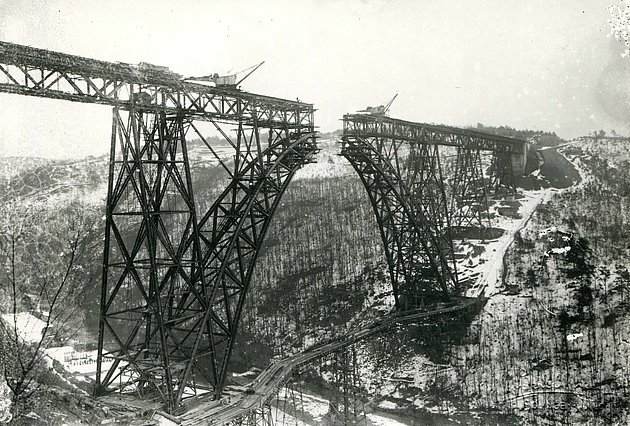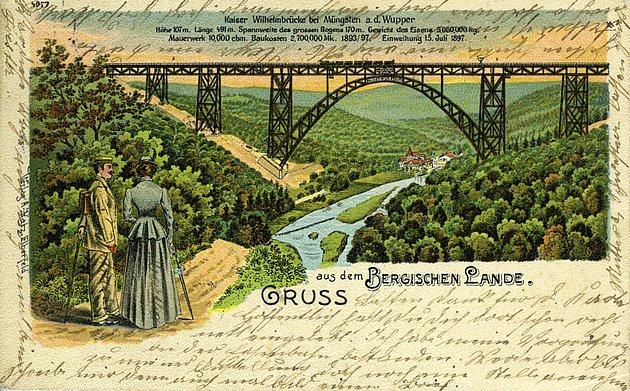
© Stadtarchiv Solingen
LINK BETWEEN EMERGING INDUSTRIAL CITIES
Towards the end of the 19th century, Solingen and Remscheid, with their cutlery and tool production, were among the emerging industrial cities in the German Empire. For the transportation of goods, both cities were independently connected to the railroad network, but on different lines and without a direct connection to each other. Thus, although there were only eight kilometers between Remscheid and Solingen in the straight line, the shortest rail route was 44 kilometers and went via Vohwinkel, Elberfeld and Barmen.
Therefore, there was a demand for a direct connection. It was not only intended to revitalize the traffic relationship between the cities, but also to pave the way to the industries, markets and traffic routes on the Rhine. However, the deeply incised valley of the Wupper demanded a complex and expensive technical solution. It was therefore not easy to convince the Prussian state of the necessity of building a bridge.
In 1890, the two cities were able to prevail: The Prussian parliament approved almost five million marks for the construction of a direct rail link from Remscheid to Solingen, including the construction of the bridge over the Wupper. The towns bore the cost of acquiring the land.
The Royal Railway Directorate in Elberfeld was given the task of determining the construction system and awarding the construction work. A competition was held at the end of 1891, and in July 1892 designs were available for a truss bridge, a cantilever bridge and an arch bridge.
THE ARCH BRIDGE WINS THE CONTRACT
The proposal of the Gutehoffnungshütte in Oberhausen did not meet with approval: the scaffold bridge with 20 piers and a maximum span of 30 meters would have had a decidedly negative visual impact on the entire valley. The Harkot company from Duisburg was also unconvinced: their cantilever bridge would have been too expensive. The contract was awarded to Brückenbauanstalt Gustavsburg of Maschinenbau- und Aktiengesellschaft Nürnberg (today MAN) for its ambitious design: an arch bridge with trestle bridges on both sides. The advantage: the bridge piers stood on solid ground, and a central pier in the riverbed was not required. The challenge: the restrained arch, which was very complicated to calculate statically. The material was also innovative: mild steel instead of wrought iron.
CONSTRUCTION BEGINS
Before construction of the giant bridge began with the groundbreaking ceremony on February 26, 1894, a great deal of preliminary work had already been done. For example, a trestle bridge was erected as a transport route for construction materials, plant and storage areas were set up, and the power supply was prepared. Most of the machines - pumps, cranes, concrete machines or a material train - were electrically operated, and the construction site was also to be well illuminated in poor lighting conditions.
On site, earthworks for piers and abutments started in 1894, and the steel bridge parts were manufactured at the Gustavsburg bridge construction plant. The aim was to manufacture as much as possible at the plant in order to minimize on-site work, especially riveting. Activities at great heights were not only dangerous, but also difficult to perform as precisely and carefully as in a covered factory hall at ground level.
THE ARCH CONCLUSION
In the spring of 1895, things got exciting: On the Solingen and Remscheid sides, assembly of the scaffold piers began first, followed in the summer of 1896 by the large connecting arch. Under the gaze of many onlookers, the erectors worked at dizzying heights. The free projection was the greatest challenge: the two sides grew toward each other - without any scaffolding at all. The main work of erecting the arches fell during the winter months of 1896/1897. The cantilevers, at the top of which were slewing cranes, were exposed to fierce winds. In the last week of March, violent storms raged almost daily, accompanied by heavy thunderstorms. Nevertheless, the arch was closed on March 21, 1897, and on March 22 the last of 950,000 rivets was driven in, accompanied by music.
INAUGURATION IN JULY 1897
The engineers and workers had braved the wind and weather to meet the tight schedule: The arch closing, also the "topping-out ceremony" for the "Thalbrücke bei Müngsten" was set for March 22, 1897, the 100th birthday of Kaiser Wilhelm I, a national holiday in the empire. On July 3, 1897, the first locomotive, decorated with wreaths, drove over the structure, and on July 15, it was ceremoniously inaugurated and opened to traffic. Although Kaiser Wilhelm II was invited to the inauguration, he was represented by Prince Leopold of Prussia. The emperor did not visit the bridge until two years later, on August 12, 1899.



